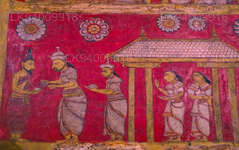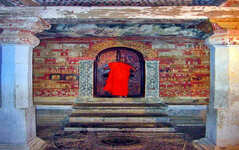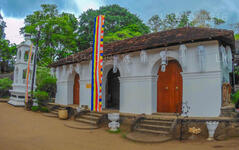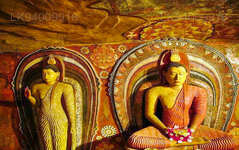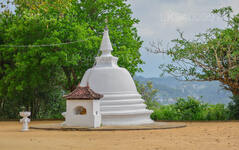
캔디 시티
스리랑카 중부의 그림 같은 도시 캔디는 풍부한 문화 유산, 활기찬 축제, 그리고 아름다운 자연 경관으로 유명합니다. 울창한 언덕에 자리 잡은 캔디는 유네스코 세계문화유산으로 지정된 불치사(Temple of the Tooth Relic)가 있는 곳으로, 역사와 아름다운 자연이 어우러진 매혹적인 도시입니다.
Degaldoruwa Raja Maha Vihara
Amongst the rocky slopes and green valleys of rural Kandy lies a hidden treasure; the Degaldoruwa Raja Maha Vihara. This temple awes those who view it with its incredible Kandyan era frescoes. Construction of the temple began in the late 1770s under the reign of King Kirti Sri Rajasinha and was completed under the reign of his brother Rajadhi Rajasinha years later.
Legend
According to folklore a farmer was exploring the area and found a crevice between two rocks. On venturing into space he found a cave with a pile of golden sickles. The farmer was delighted with his discovery but feared retribution from some strange power. So he simply took only one sickle every morning and, after using it in his fields, returned it in the evening. His fields yielded an extremely healthy harvest and the farmer attributed it to the golden sickle. But then he became greedy. After all, he had been taking the sickles every day and there had been no ill effects, and there was a whole pile of them. So on the very last day of the harvest, he took two sickles instead of one and did not return one of them.
But unknown to the farmer, there had indeed been a guardian for the treasure. The guardian noticed the farmer taking the sickles, but kept quiet as he always returned them. On the day that the farmer took one sickle for himself, the guardian saw it at once and confronted him in his home. The terrified farmer immediately rushed to the crevice and returned the golden sickle that he had stolen. The guardian, who had been disappointed, then sealed the crevice by fusing the two rocks together. However, the villagers got to know this story and informed the king, Kirti Sri Rajasinha; who then ordered that the cave be found and a temple erected in it.
The Structure
- The temple is hollowed out of a 40 foot rock outcrop extending a natural cave. It consists of an elegant rock shelter with two roofed antechambers in front; a drummers’ hall and an image house; and the main shrine room cut into the rock itself. The two antechambers are constructed outside the rock outcrop and have wooden roofs.
- The architecture is unusual for the period as the drummers’ hall is not usually attached to the main temple.
- The image house is located through a set of old wooden doors, situated under a carved wooden Dragon Arch. It preserves a moonstone and a sequence of elaborate and colorful paintings showing scenes from four Jātaka tales, which tell the stories of the previous lives of Buddha.
- The door of the shrine room is banded with metal and once had jewels embedded within it. The inner walls of the shrine are completely covered in paintings; including the door.
- In addition to this main structure, there is a bo tree and a stupa on a plateau on the summit of the rocky outcrop above the temple. They can be reached by stairs carved into the temple.
The Frescoes
The paintings of Degaldoruwa, which are supposed to be some of the best of the Kandyan era, are believed to be the work of four ‘Sittara’ artists. The finest of these paintings grace the ceiling of the temple; ‘Mara Yudde’, an artistic depiction of Buddha’s internal spiritual battle against Māra, the demon of death, rebirth, and desire.
The murals are unique in that all the elements; the people, the trees and the animals; are a uniform size and only the front views of ]people are shown. The trees have a stylized form, with their branches and leave spreading out to either side. The individual elements, such as the adornments on the elephants and the uniforms of the attendants, are portrayed in great detail. All of the colors used by the artists in the murals were created from the barks
캔디 지구 소개
캔디 지구는 스리랑카 중부 지방에 위치하고 있습니다.스리랑카의 7개 세계문화유산 중 하나인 캔디는 16세기에 옛날 캔디 왕조의 왕들이 살았던 곳이자 나라의 모든 음악, 예술, 공예, 문화의 원천이었습니다.콜롬보에서 약 129km 떨어진 캔디는 구릉 지대에 자리 잡고 있으며 모든 시선은 캔디 호수가 매력적인 특징을 이루는 도시 중심부로 쏠립니다.캔디는 스리랑카에서 큰 종교적 의미를 지니고 있는데, 이 매력적인 도시에 달라다 말리가와 또는 "치아 사원"이 있고, 그 안에 부처님의 신성한 치아 유물이 잘 보관되어 있기 때문입니다.페라데니야 왕립 식물원은 페라데니야 시내 중심에서 서쪽으로 약 5km 떨어진 곳에 위치하고 있으며, 매년 120만 명이 방문합니다.섬에서 가장 큰 식물원입니다. 우다와타 켈레(우다와타 숲)는 도시 중심부, 불치사 바로 북쪽에 위치한 보호 구역입니다. 캔디는 싱할라족이 다수를 차지하는 도시이지만, 무어족과 타밀족 등 다른 민족 집단이 거주하는 지역 사회도 상당수 있습니다. 캔디는 스리랑카 경제의 중심지인 콜롬보에 이어 두 번째로 큰 도시입니다. 많은 주요 기업들이 캔디에 대규모 지사를 두고 있으며, 섬유, 가구, 정보 기술, 보석 등 다양한 산업이 이곳에 자리 잡고 있습니다. 또한, 수많은 농업 연구 센터가 캔디에 위치해 있으며, 전국의 음악, 예술, 공예, 문화의 발원지이기도 합니다. 콜롬보에서 약 129km 떨어진 캔디는 구릉 지대에 자리 잡고 있으며, 모든 사람의 시선은 캔디 호수가 있는 매력적인 도시 중심부로 쏠립니다. 캔디는 스리랑카에서 매우 중요한 종교적 의미를 지니고 있는데, 이 매력적인 도시에 달라다 말리가와(불치사)가 자리 잡고 있으며, 이곳에는 부처님의 성스러운 불치가 잘 보관되어 있기 때문입니다.
중부 지방 소개
스리랑카 중부 지방은 주로 산악 지형으로 이루어져 있습니다. 이 지방의 면적은 5,674km²이고 인구는 2,421,148명입니다. 주요 도시로는 캔디, 감폴라(24,730명), 누와라 엘리야, 반다라웰라가 있습니다. 인구는 싱할라족, 타밀족, 무어족이 섞여 있습니다. 언덕 주도인 캔디와 누와라 엘리야는 모두 중부 지방과 스리 파다에 있습니다. 이 지방은 1860년대에 파괴적인 질병으로 인해 이 지방의 모든 커피 농장이 파괴된 후 영국인이 심은 유명한 실론 차를 많이 생산합니다. 중부 지방은 캔디, 감폴라, 해튼, 누와라 엘리야와 같은 언덕 역 마을이 있어 많은 관광객을 유치합니다. 템플 투스 또는 달라다 말리가와는 중부 지방의 주요 성지입니다. 기후는 시원하며, 해발 1,500m 정도의 많은 지역에서는 종종 밤에 쌀쌀합니다. 서쪽 경사면은 매우 습하며, 일부 지역에서는 연간 강수량이 거의 7,000mm에 달합니다. 동쪽 경사면은 북동 몬순의 영향으로 비가 거의 내리지 않아 중건기 지대에 속합니다. 캔디의 기온은 24°C에서 해발 1,889m에 위치한 누와라 엘리야의 기온은 16°C에 불과합니다. 스리랑카에서 가장 높은 산은 중부 지방에 있습니다. 지형은 대부분 산악 지대이며, 깊은 계곡이 지형을 가로지르고 있습니다. 두 개의 주요 산악 지역은 캔디 동쪽에 있는 중앙 산괴와 너클스 산맥입니다.


